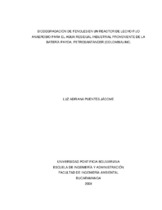| dc.contributor.advisor | Kopytko, María Irene | |
| dc.contributor.author | Puentes Jácome, Luz Adriana | |
| dc.coverage.spatial | Seccional Bucaramanga. Universidad Pontificia Bolivariana. Escuela de Ingenierías. Facultad de Ingeniería Ambiental | spa |
| dc.coverage.temporal | 2008 | |
| dc.date.accessioned | 2013-02-26T17:40:36Z | |
| dc.date.available | 2013-02-26T17:40:36Z | |
| dc.date.created | 2008-03-10 | |
| dc.date.issued | 2013-02-26 | |
| dc.identifier.uri | http://hdl.handle.net/20.500.11912/59 | |
| dc.description | 158p.:(pdf); il; tablas; gráficas | spa |
| dc.description.abstract | En su fase inicial, el proyecto evalúo el potencial de biodegradación de fenoles en el agua residual industrial de la batería Payoa, PetroSantander (Colombia) Inc. Se encontró un elevado potencial, gracias a la gran abundancia de microorganismos aislados de las muestras de agua residual y lodo provenientes de las piscinas de tratamiento, así como la notoria adaptación de las bacterias a altas concentraciones de fenol, junto con un alto rendimiento de los ensayos de tratamiento realizados (hasta un 86% de eficiencia de remoción). Posteriormente, se optimizó el sistema de tratamiento propuesto a escala laboratorio, en reactores de lecho fijo con biopelícula adaptada, a través de un diseño experimental factorial 22, en dos niveles (máximo y mínimo) y dos variables: tiempo de retención y presencia o ausencia de un lecho de carbón activado; la variable de respuesta fue la concentración de fenoles. Las óptimas condiciones de tratamiento para baja y alta concentración de fenol (2,14 y 9,30 mg/l) se lograron con presencia de carbón activado y tiempo de retención de 18 horas (83 y 81%); para la concentración intermedia (6,13 mg/l) de fenol, se generó un mayor rendimiento a las 24 horas de tiempo de retención, con la presencia de carbón activado (86%). La presencia del lecho de carbón activado, no incrementó en gran medida la eficiencia de remoción de fenoles. El aumento del tiempo de retención de 18 a 24 horas, tampoco indicó una mejora en la remoción de fenoles. Finalmente, se diseñó el sistema de tratamiento piloto para un 10% del caudal total de la batería, teniendo en cuenta la circulación del agua tratada a un reactor secundario, o la recirculación al mismo reactor, logrando disminuir la concentración de fenol a valores aceptables por la norma de vertimientos vigente en Colombia. | spa |
| dc.description.abstract | The research evaluated the biodegradation potential of phenols in the industrial wastewater of Camp Payoa, PetroSantander (Colombia) Inc. An elevated potential was established, taking into account three important factors: the great abundance of microorganisms found in the wastewater and sludge samples collected in the treatment lagoons, the notorious bacterial adaptation to high phenol concentrations (10 mg/l) and the elevated efficiency percentages (up to 86%) obtained in the conducted laboratory tests. The treatment system proposed in laboratory, which consisted of fixed-bed bioreactors with adapted bacterial biofilm, was optimized using a 22 factorial experimental design. The variables considered, studied in their maximum and minimum level, were: hydraulic retention time and the presence or absence of a granular activated carbon layer. The response variable was phenol concentration. The optimum treatment conditions for low and high phenol concentration (2,14 y 9,30 mg/l), were obtained with the presence of granular activated carbon and 18 hours of hydraulic retention time. The best result for the intermediate phenol concentration (6,13 mg/l) was obtained with a hydraulic retention time of 24 hours and the presence of granular activated carbon. Nevertheless, the presence of the granular activated carbon layer was not important in terms of significant increases in phenol removal. Even more, the increase of hydraulic retention time from 18 to 24 hours, showed no important improvement in phenol removal. The pilot wastewater treatment system for Camp Payoa, was designed for 10% of the total generated wastewater, taking into account the conduction of the treated water to a secondary bioreactor or the recirculation of the water to the same bioreactor, in order to effectively reduce the phenol concentration, obtaining accepted values by the Colombian regulation concerning this matter. | |
| dc.language.iso | es | |
| dc.rights | Attribution-NonCommercial-NoDerivatives 4.0 International | * |
| dc.rights.uri | http://creativecommons.org/licenses/by-nc-nd/4.0/ | * |
| dc.subject | Aguas residuales | |
| dc.subject | Fonoles | |
| dc.subject | Biodegradación | |
| dc.subject | Petrosantander - Colombia | |
| dc.subject | Carbón compuestos orgánicos | |
| dc.subject | Ingeniería ambiental | |
| dc.subject | Tesis y disertaciones académicas | |
| dc.title | Biodegradación de fenoles en un reactor de lecho fijo anaerobio para el agua residual industrial proveniente de la bateria payoa, Petosantander (Colombia) Inc. | spa |
| dc.type | bacherlorThesis | spa |
| dc.rights.accessRights | openAccess | spa |
| dc.type.hasVersion | publishedVersion | spa |
| dc.identifier.instname | instname:Universidad Pontificia Bolivariana | spa |
| dc.identifier.reponame | reponame:Repositorio Institucional de la Universidad Pontificia Bolivariana | spa |
| dc.identifier.repourl | repourl:https://repository.unab.edu.co/ | |


